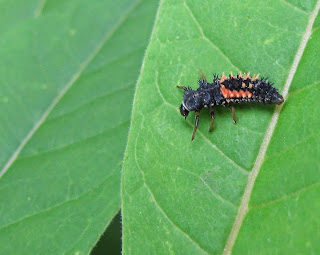The Walking Dead is a popular television show these days, but reality is perhaps even more sinister. Did you know that there are fungi that hijack the brains of insects causing them to behave in ways that benefit the fungus? It's true, and you have probably seen evidence of this macabre life cycle without knowing the answer to the mystery.
Cheryl Harner, a naturalist and writer at Weedpicker's Journal, asked me about this bizarre phenomenon a couple of years ago, and I always meant to learn more about it myself. You owe it to yourself to check out her blog, and I'll try to complement her post rather than compete with it. She did an excellent job of researching and linking, though.
It is not just grasshoppers and ants that are victimized by what are called "entomopathic" fungi. Flies are among the most conspicuous of hosts. You have probably seen flies clinging to foliage or twigs in odd, contorted positions, with bloated abdomens. The spores of the Entomophthora muscae fungus have their hosts literally bursting at the seams, the membranes between the abdominal segments.
Meanwhile, grasshoppers and related orthopterans are plagued by Entomognatha grylli, and lady beetles are often afflicted with Laboulbeniales fungi.
The life cycle of fungi in the order Entomophthorales begins when a spore lands upon an insect. However, many of the fungi are very host-specific, so if a spore lands on the "wrong" bug it is likely done for. Should the spore contact the correct host, it soon germinates, penetrating the cuticle of the insect and growing internally, absorbing the host's nutrients, eventually killing it. Before the doomed creature perishes, the fungus does something remarkable. In many cases it stimulates the host to seek a high point, either by climbing or flying, whether or not the insect normally performs such behavior. This phenomenon is sometimes referred to as "summit disease."
Once the host insect ascends a grass stem, for example, the fungus sends out special structures called rhizoids that are white, thread-like filaments. These fibers often emerge from the insect's tarsi ("feet") or mouthparts, anchoring the bug to the substrate such that it is not easily dislodged after death. Now the spores erupt, sometimes in the form of fruiting bodies like other fungi, or simply exuding from holes in the host's cuticle.
Grasshoppers are among the most conspicuous victims if only because of their size, but most types of insects, and spiders, too, are vulnerable to fungal infection. The typical appearance of fungus victims are stiff, dessicated specimens that are essentially mummified.
Fungi in the order Laboulbeniales affect beetles in particular, and are very different in their mode of dispersal and effect on the host. Hesperomyces virescens apparently afflicts only the Multicolored Asian Lady Beetle, Harmonia axyridis, at least here in North America. It is microscopic, and is essentially a sexually transmitted disease since the overwhelming means of infection occurs during mating of the host. Spores can also transfer when large groups of overwintering lady beetles force the insects to rub against each other.
Most adult beetles exhibit symptoms in the form of tiny, yellow, scale- or flake-like protrusions from the cuticle, especially at the tip of an elytron (wing cover). These are the fruiting bodies, called perithecia, from which spores are issued, if I comprehend the literature and language of mycology correctly. Interestingly, the fungus has little or no effect on the host, but depends on it for reproduction.
When one thinks of mortality factors that affect insects, or most other animals, we tend to forget the impact of fungal organisms. Maybe I have seen one too many episodes of the television show Monsters Inside Me, but I have a whole new respect for fungi now. It helps to remember that fungi are often very host-specific, so handling a fungus-ridden bug is not going to pose a health threat to a human. As far as we know.
Sources: Eiseman, Charley and Noah Charney. 2010. Tracks & Signs of Insects and other Invertebrates. Mechanicsburg, Pennsylvania: Stackpole Books. 582 pp.
Parker, Abigail M., et al. 2010. "with Labioulbeniales fungus," Bugguide.net.












